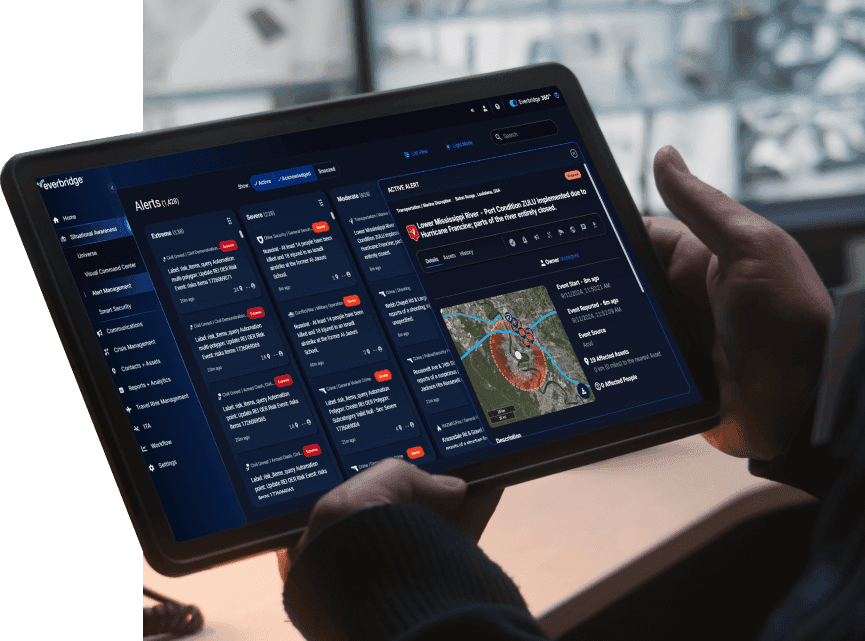Today’s leaders are more exposed than ever before, due to constant digital connectivity and public visibility. This new era brings complex risks that go far beyond traditional physical security. Successful executive protection now requires a strategy that addresses both digital and physical threats, often occurring at the same time.
Recent high-profile incidents highlight the rising challenges. Organizations have a duty of care to protect their leaders, but is your executive protection program keeping pace with increasing risks? A new study undertaken by ASIS International and Everbridge uncovers critical gaps and opportunities, and this post explores how the threat landscape is evolving, what challenges organizations face, and the key strategies to build a robust protection program.
Executive protection in a shifting threat environment
Executive protection has surged up the agenda. According to the new study, 42% of security professionals report a significant increase in focus on executive protection in just the past 18 months, a clear response to a rapidly growing and evolving threat landscape.
Two major drivers are fueling this urgency:
- Rising public threats (72%): Social media and online forums amplify dissent and anger, often breeding direct threats against executives.
- High-profile incidents (69%): Events such as the assassination of a prominent CEO in 2024 have put executive risk on center stage for boards and security leaders.
The lesson is clear: executive visibility, including digital presence and company communications, increases vulnerability. Threats are now global, persistent, and often initiated online.
The modern threat: where digital meets physical
Threats today arise from the intersection of online and offline worlds, creating complex scenarios that traditional security alone cannot address.
Physical threats enhanced by technology
Traditional kidnapping and assault scenarios have evolved. Attackers use digital tools to plan incidents, analyze public routines, and bypass conventional security. Publicly shared information makes executives’ movements predictable, while personal tech can compromise safety almost anywhere.
Escalating cybersecurity threats
Cyberattacks against executives are more frequent and sophisticated. Deepfake technology, for example, can create fake video calls and social media content nearly indistinguishable from reality. One organization lost $25.6 million in 2024 when a finance employee joined a deepfake video call with “colleagues.” Online intimidation and digital surveillance are now common precursors to real-world attacks.
Challenges holding back executive protection
As risks mount, many organizations struggle to implement effective protection programs. The recent ASIS and Everbridge research spotlights disconnections between awareness, funding, and action.
Budget and executive buy-in
Budget limitations (58%) are the largest barrier, followed by executive non-compliance (47%). These challenges reinforce one another: without executive support, security programs lack funding; without resources, their value remains unproven. For programs to succeed, security must be framed as a business enabler, key to continuity, reputation, and leadership confidence, not as a mere checkbox.
Gaps between awareness and action
According to the ASIS and Everbridge research, there are stark differences between how important security professionals rate various practices and their ability to implement them:
- Online threat monitoring: 65% say it’s critical; only 51% feel equipped to do it well.
- Protecting digital assets & secure communications: 57% rate it highly; just 42% feel capable.
- Behavioral threat profiling: 48% see it as important; only 33% have solid capabilities.
These gaps reveal that while digital risks are widely recognized, many organizations aren’t yet equipped to manage them effectively.
Key strategies for modern executive protection
To address these challenges, organizations must modernize their approaches, merging analysis, technology, and people.
Integration of digital and physical security
Threats originating online can escalate rapidly into the physical world. Effective executive protection uses open-source intelligence (OSINT) and social media monitoring not just to track sentiment, but to identify specific, actionable threats. The study found that while OSINT is widely used (82%), most organizations lack the tools for real-time analysis or behavioral threat detection. Investing in these technologies makes it possible to move from reactive to proactive risk management.
Proactive travel risk management
Executive travel is still a top exposure. Yet many companies take a piecemeal approach:
- 18% rarely or never assess travel risks in advance.
- 25% don’t offer pre-travel safety briefings.
- 30% only monitor intelligence after a known threat arises.
This reactive stance leaves executives vulnerable. Best practices demand pre-trip risk assessments for every journey, thorough briefings, and ongoing monitoring, not just after a threat emerges.
Governance and training
High-level support is essential. Board oversight, adequate resources, and executive participation in security planning are crucial, not just for physical threats but as part of broader cybersecurity compliance. New SEC rules underline the need for C-suite involvement.
Yet training often lags. While situational awareness training is common, scenario-based exercises are rare, despite being invaluable for testing protocols. Fewer than half of organizations offer executives training in emergency procedures, IT security, or even self-defense, leaving many leaders unprepared for new-age threats.
Building a culture of security
Technology is only half the battle. Fostering a culture where leaders understand risks, model best practices, and cooperate with security staff is vital. Security teams should track incidents and measure the effectiveness of their programs, using data to make the business case for ongoing investment.
The path forward: resilient, data-driven protection
To secure buy-in and resources, security leaders must present protection as a strategic investment and support this with measurable results. Yet, according to the ASIS and Everbridge study, more than a third of organizations lack any formal evaluation process for executive protection.
By implementing clear KPIs, tracking incidents, and analyzing outcomes, organizations can demonstrate value, adjust tactics, and ensure constant improvement.
As the threat landscape grows more complex, protecting today’s high-profile leaders demands an integrated, data-driven approach. Digital and physical security must operate in tandem, powered by proactive intelligence, solid processes, board support, and comprehensive training.
Is your protection program evolving with the times? To benchmark your organization or learn how to strengthen executive protection, download the full Executive Threat Environment Report.
Want deeper insights and practical advice? Watch our on-demand webinar, Executive Protection in a Volatile World, and gain strategies directly from leading experts.





